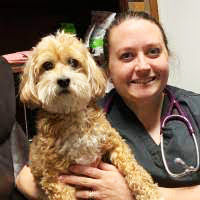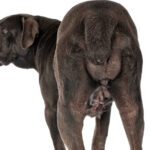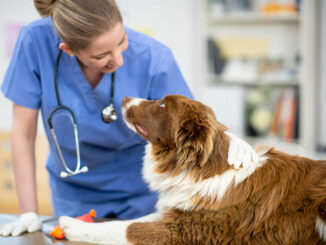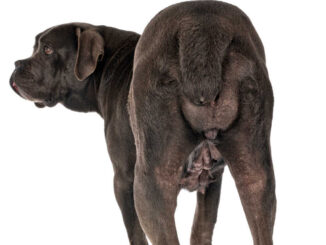
This article was updated on June 12th, 2024
So your dog is expecting! How exciting! Hopefully she’ll have an easy pregnancy and a simple delivery with no complications. You may notice some discharge coming from the vulva of your dog, which can be either normal or a sign of something wrong. How can we tell the difference? How do you know when something is wrong?
In this article, our veterinarians Dr. Sara Ochoa and Dr. Jamie Whittenburg describe normal vaginal discharges often seen during pregnancy (week by week), and explain when to be concerned.
Normal vaginal discharges are often seen in pregnant dogs
Several factors are important when determining if vaginal discharge is a problem, including its color, odor, and timing (during the 9 weeks of pregnancy). We have described below normal vaginal discharges that are often seen during the nine weeks of pregnancy, week by week:
First 2-3 weeks: Pregnant dogs should not have a discharge
“Pregnant dogs should not have discharge during the first 2-3 weeks. If your pregnant dog has a vaginal discharge, you should call your veterinarian, as it is possible that your dog is having a miscarriage. Abnormal vaginal discharge is usually brown, black, green, or purulent (pus-like).”
It is possible to lose a pup or two while some embryos remain viable. In week 3, if your dog is small and thin enough, a veterinarian may be able to palpate the embryos at this time. Please do not attempt to do this yourself, as it is possible to harm them. At the end of week three, you can confirm the pregnancy with a blood test.
Week 4: clear discharge (tinged white or yellow)
“During the fourth week of pregnancy, you may see clear discharge from your pregnant dog’s vulva. It should be a small to moderate amount. As long as there is no odor, pus, or blood, this is normal and nothing to worry about. “
There is a mucus plug that covers the cervix during pregnancy. It sometimes leaks a bit, causing the discharge. You may see clear discharge from your pregnant dog’s vulva. The clear fluid may be tinged white or yellow.
Also, during the fourth week, you will notice your momma dog’s appetite increase even more, as well as her need for naps! She may vomit occasionally. Her nipples will start to become enlarged.
Week 5: clear or clear white/yellow discharge
Your pregnant dog will continue to have a small to moderate discharge. It may be clear, clear white, clear yellow, or slightly tinged pink. It will have a mucus-like consistency. There is no need for concern unless the discharge has an odor or contains blood or pus.
Your dog’s abdomen will increase in size and may become rigid as she starts to gain weight. Her nipples will get even bigger, and the veins on her belly will become dark and readily visible.
Weeks 6, 7 & 8: clear, white, yellow, or pink-tinged mucus-like discharge
In week 6, your pregnant dog will continue to gain weight. You may see small to moderate amounts of clear to white, yellow, or pink-tinged mucus-like discharge. Your girl’s appetite may decrease, taking her daily intake back to her pre-pregnancy normal.
In week 7, the abdomen will become more distended, a lot of weight will be gained, and the hair on the belly around the nipples will start to shed. Milk may be seen coming from the nipples, and the mammary glands will start to swell. A clear or white or yellow-tinged mucus-like discharge may be seen.
In week 8, your dog’s abdomen will be distended. She will have a decreased appetite and will start nesting behavior. Her mammary glands will become even larger. You should set up a whelping box at this time, as she is soon to deliver. The mucus-like discharge previously seen may continue.
Week 9: the mucus plug covering the cervix will be expelled
During the ninth week, your dog will display more nesting behavior. She will have a decreased appetite and may be nauseous. The mucus plug covering the cervix will be expelled. It looks like a clump of stringy mucus similar to raw egg whites. Your pregnant dog will most likely lick up the mucus plug before you have a chance to see it. The plug is expelled hours to days before whelping.
Call your vet if your pregnant dog’s vaginal discharge has an odor, is black or red, or appears purulent
“You should call your veterinarian if your pregnant dog’s vaginal discharge has an odor, is black or red, or appears purulent. These are signs that your dog is either suffering from a medical issue or may be experiencing a miscarriage.
You should also call your veterinarian if your dog is also showing signs of illness including vomiting, fever, abdominal pain, weakness, foul odor, extreme lethargy, decreased appetite, excessive drinking, and urination”
Below is a description of the types of vaginal discharges that you should not ignore & may warrant a call to your vet as soon as possible:
- Vaginal discharge with an odor: Any vaginal discharge that has an odor is reason for concern, and a veterinarian should be called right away. The odor is indicative of either an infection or a dead pup.
- Black vaginal discharge. Black discharge coming from your pregnant dog should cause serious concern. It is often seen with miscarriages. If seen, you should call your veterinarian immediately.
- Red or bloody vaginal discharge. If you see bloody discharge from your pregnant dog’s vulva, call your veterinarian right away; hemorrhage during pregnancy or immediately prior to whelping is a sign of pregnancy loss.
- White or yellow pus-like vaginal discharge. Purulent or pus-like discharge from your dog’s vulva is a major concern. You should call your veterinarian right away, as your dog may have a uterine infection called a pyometra.
This is life-threatening to both the mother and pups. Pyometras progress quickly; by the time you see pus-like discharge, the infection is already severe. A dog with a pyometra can progress from slightly sick in appearance to deathly ill within hours.
- Green vaginal discharge from a pregnant dog before any pups are born. If you see a green discharge, a pup should be born within fifteen minutes. If no pup follows the fluid, this is the reason for concern, and the veterinarian should be called. The green fluid called uteroverdin is released during birth when the placenta separates from the uterine wall. It is normal if seen after a pup is born.
Other signs of fetal death include vomiting, fever, abdominal pain, weakness, foul odor, extreme lethargy, decreased appetite, excessive drinking, and urination.
It can be hard to discern illness from normal pregnancy behavior. The best solution to this is to become familiar with the progression of the normal dog gestation cycle and have close ties to your veterinarian.
Prior to whelping, a green discharge may be seen coming from your pregnant dog’s vulva
This is the uteroverdin, the green pigment of the placenta. When the placenta detaches from the uterine wall uteroverdin is released. Once this green-to-greenish-black fluid is seen, a pup should be born imminently. If no pup comes within fifteen minutes after the fluid, you should call your veterinarian immediately, as there is a good chance that the pup is distressed.
During labor, it is normal to see the green discharge as long as puppies are also coming out! A small amount of brown discharge during labor may be seen and is not a cause for concern if the delivery is going well.
Veterinarian Tip: Dogs typically do best with as little human intervention as possible during whelping. Being too involved will cause the mother stress and may lead to complications.
Types of vaginal discharges seen in dogs after giving birth
After your dog gives birth, you may see a few different types of discharge. These are common types seen and what they could mean:
- Greenish/black: If your dog has not passed all of the placenta material, you will see this pass in the few hours after they have given birth. This is often a green-to-black color.
- Red: This indicates that there is some bleeding in the uterus. A very small amount of blood can be normal. If your dog is bleeding a lot, it is an indication that something could have torn, and your dog will need to see a vet right away.
- Reddish brown: This is a normal discharge that is seen for a few weeks after giving birth. If this lasts for longer than a few weeks, your dog will need to see your vet.
- Creamy Yellow: This is an indication of pus in the uterus or a pyometra. This is often a medical emergency and will need immediate veterinary attention.
- Clear mucous: This is often seen with mild cases of vaginitis or inflammation of the vulva. This can normally occur for a week after birth.
If your dog is not eating or drinking well, appears lethargic, or seems like they do not feel well, it is best to have them seen by your vet as soon as you can. Your vet will be able to determine the cause of the issue and get them the appropriate treatment quickly.

References:
- Wenche, K. F. and Scient, 2008, ‘Pregnancy loss and abortion in dogs’. British Small Animal Veterinary Congress
- Russo, A., Pellegrino, F.J. and Corrada, Y., 2014, ‘Simultaneous pyometra and viable puppies’ gestation in a bitch’, Open Vet J.2014; 4(2): 82-84, PMCID:PMC 4629608
- Brooks, L., ‘Common pregnant dog emergencies to watch out for’, EmergencyvetsUSA
Related posts:
Disclaimer: This website's content is not a substitute for veterinary care. Always consult with your veterinarian for healthcare decisions. Read More.










Be the first to comment